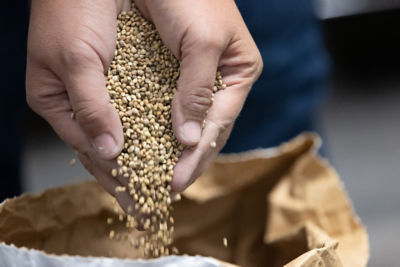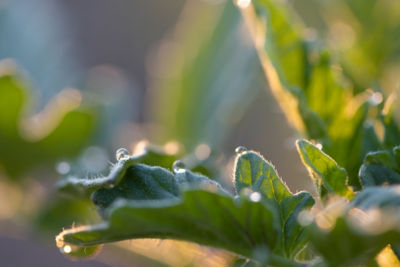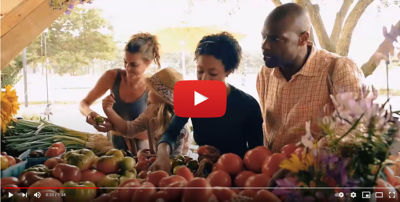Click here to download a PDF version of this spotlight.
» Blindness of tomatoes is a condition where seedlings lose their apical meristem and stop producing new stems, leaves, and flowers.
» The incidence of blind seedlings in tomatoes is influenced by genetics (varieties) and environmental conditions during germination and early seedling development.
» Adjusting germination conditions when using blind-sensitive varieties is the primary means of preventing the problem.
Blindness of seedlings is a condition that occurs when tomato seedlings spontaneously lose their apical meristems (growing points) and stop producing new stems, leaves, and flowers.1 The condition is also known as apical meristem decline, shoot apical meristem arrest, and bud-less.2,3 Blind seedlings also occur in peppers, cauliflower, and broccoli.1,2 The incidence can range from 10 to 90% of the production of hybrid seeds in some areas and result in substantial production losses. Blindness is often associated with the stopping of root growth, and blind plants usually have fewer, thicker, and deformed leaves.
Long-season crops (melon, pepper, tomato, and watermelon) can require three to four months of weed control. Weed management strategies feasible in a field of staked tomatoes may not be possible in a watermelon field during the vining stage.3
Depending on when the meristem is lost, axillary meristems (buds) can take over, resulting in multi-stemmed plants with reduced growth.3 If the meristem is lost in the early stages of seedling development, no true leaves and no axillary buds may form (Figure 1A), so the seedling will not develop past the cotyledon stage. When the meristem is lost at later stages, some true leaves, internodes, and possibly one or two flower clusters will form (Figure 1B). If axillary buds were formed, they can generate side-shoots, and the plants can recover, but growth and production will be delayed.2,5 There are genetic components to blindness in tomatoes, with some varieties more sensitive to the condition than others. Still, the occurrence of blindness is often associated with suboptimal environmental conditions during germination and emergence. In tomatoes, germination temperature, light intensity, and seed treatments such as priming appear to influence the formation of blind seedlings.1,2,4,5
THE APICAL MERISTEM
 Figure 1. Blind tomato seedlings where the apical meristem disappears (A) before the first set of true leaves primordia are formed and (B) after the first true leaf initials are formed from the apical meristem.
Figure 1. Blind tomato seedlings where the apical meristem disappears (A) before the first set of true leaves primordia are formed and (B) after the first true leaf initials are formed from the apical meristem.
 Figure 2. This diagram of a cross section of a tomato apical meristem shows the central zone (CZ), peripheral zone (PZ), rib zone (RZ), and leaf primordia (LP).
Figure 2. This diagram of a cross section of a tomato apical meristem shows the central zone (CZ), peripheral zone (PZ), rib zone (RZ), and leaf primordia (LP).
All of the aerial parts of a tomato plant develop from the shoot apical meristem, which contains undifferentiated stem cells that can change and be the basis for developing leaves or stem growth. The apical meristem is made up of three zones (Figure 2). The central zone is the reservoir of stem cells and is the site for maintaining the meristem. The rib zone gives rise to the stem tissue. The peripheral zone gives rise to lateral organs, including leaves and flower buds that produce flowers and fruit. Both genetic and hormonal mechanisms control the maintenance of the central zone and differentiation into tissues and organs.2 The plant hormones cytokinin, gibberellin, and auxin are also known to influence the growth and development of the meristem cells.
There is a continuous succession of apical meristems with a normal tomato seedling. Each apical meristem produces three to four leaves (nodes) and lateral buds, then terminates. The most recently formed lateral bud will then take over as the apical meristem to repeat the process, which is why tomato stems grow in a zigzag (sympodial) pattern.3,6
The blind condition is most likely to result from a disruption of the stem cell maintenance system. Stem cells require continuous maintenance to grow and differentiate appropriately, and various stress factors can prevent the maintenance system from working correctly. With a lack of proper maintenance, the stem cells do not die, but they change into other types of cells, and the pool of stem cells is lost, resulting in a blind plant.2,3 Blind plants usually form before the five-leaf stage.
Several genes that play roles in meristem development have been identified. These may be involved in varietal differences in susceptibility to blindness, but that connection has not been well studied. There is, in fact, a “blind” gene that has been identified in tomatoes. Other genes involved with meristem maintenance and growth include the Defective Embryo and Meristem gene, the EXPELLED SHOOT gene, and the GOBLET genes. However, the mechanisms by which these genes may influence the incidence of blind seedling development are not well understood.2,4,5
GERMINATION CONDITIONS
Temperature: High temperatures, especially during the first few days of germination, are among the most critical factors affecting the incidence of blind seedlings in tomatoes.4,5 Studies have shown that temperatures of 77°F (25°C) and above during the first two or three days of germination increase the likelihood of blind seedling formation in blind-sensitive tomato varieties. This is the phase of germination before the radicle protrudes from the seed. In one study, the highest frequency of blindness occurred in seeds exposed to 77°F (25°C) temperatures two days after sowing, one day after imbibition.2 In this study, when seeds were incubated at 68°F (20°C), the frequency of blind seedlings was less than 5%. Exposure to 77°F on day one resulted in 30% blinds with a sensitive variety. Exposure during day 2 resulted in a frequency of 40%; exposure during day 3 resulted in 30% blinds, and exposure on day 4 resulted in a blind frequency of less than 10%. While the optimal germination temperature for tomato seeds is between 77°F (25°C) and 86°F (30°C), it may be better for plant raisers to germinate seeds of blind-sensitive varieties at lower temperatures.
Light: High light intensity levels during propagation have also been shown to increase the frequency of blindness in tomato seedlings. As with temperature, the effects of high light levels on the frequency of blindness in tomato seedlings are most pronounced during the first three days after germination.5 However, with greenhouse-grown tomatoes, lower light levels are recommended for the first three weeks for un-pinched seedlings and four weeks for pinched seedlings.4 The increased likelihood of blindness with high light intensity is more evident at higher temperatures. The findings of one study suggest that elevated temperatures resulting from higher light intensities were responsible for the increased incidence of blindness rather than the light itself.2
Seed priming: Certain seed priming methods have been shown to increase the likelihood of blind tomato seedlings, and different priming treatments have differential effects on blindness on sensitive varieties.2,4 One study found that priming seeds to 35% moisture resulted in the highest frequency of blind seedlings. Fewer blind seedlings were observed when seed were primed at lower (30%) and higher (40%) moisture levels.2 As with temperature, the effects of priming were most evident in the early stages of germination, before the protrusion of the radicle. Because of the effect of seed priming on blindness, seed companies may choose to adjust the priming methods that they use for blind-sensitive varieties. Other seed treatments may also affect the incidence of blindness in tomatoes.
MANAGEMENT
Efforts to manage the formation of blind tomato seedlings need to be implemented early in the process of seedling production. Once the condition shows up, little, if anything, can be done to fix the problem because of the irreversible nature of stem cell degeneration.5 Seed production and seed treatment conditions can affect the likelihood of blind seedling formation. Growth conditions of the mother plant, seed cleaning and drying conditions, and seed treatment methods may have some effect on blind seedling formation.2 Seed companies often evaluate seed lots for percent germination under ideal conditions and also rate the vigor of seeds and seedlings based on seed germination, stand establishment, and suboptimal seedling development under suboptimal conditions. The frequency of blind seedlings may be included in the ratings of vigor.
Lowering seed priming temperatures and selecting priming methods that minimize the likelihood of blind seedling formation are steps that can be taken to manage blindness when using sensitive varieties. The primary strategy that plant-raisers can use to minimize problems with blindness in tomatoes is to lower the germination temperature when using sensitive varieties.5 Leaf removal on young seedlings may also help lower the chances of blind seedling development. For greenhouse tomatoes, this is most feasible in the summer when light intensity is higher. Reducing the amount of supplemental light for the first twelve days after pinching can also help. Additional methods for managing blindness in seedlings are to provide a very stable environment to help minimize stress and reduce the levels of carbon dioxide early in the season.4
SOURCES
1 de Jonge, J., Kodde, J., Severing, E. I., Bonnema, G., Angenent, G. C., Immink, R. G., & Groot, S. P. 2016. Low temperature affects stem cell maintenance in Brassica oleracea seedlings. Frontiers in plant science, 7, 800. https://doi.org/10.3389/fpls.2016.00800.
2 de Jonge, J. Shoot apical meristem arrest in brassica and tomato. PhD Thesis. Wageningen University.
3 Wetzstein H. Y., Vavrina C. S. 2002. Morphological evaluation of apical meristem decline in greenhouse-grown tomato transplants and the effect of mineral nutrition on its occurrence. J. Am. Soc. Hortic. Sci. 127 635–638.
4 2015. How to prevent blind plants in tomatoes? Hort Daily. https://www.hortidaily.com/article/6021089/how-to-prevent-blind-plants-in-tomatoes/.
5 2016. Plant blindness in theory and practice. 5th International Grodan Propagation Seminar. Hort Daily. https://www.hortidaily.com/article/6029659/plant-blindness-in-theory-and-practice/.
6 Rost, T. 1996. Tomato anatomy – stems: branches & leaves. Plant Biology UC Davis. https://labs.plb.ucdavis.edu/rost/tomato/Stems/Branching.html.
Websites verified 7/5/2022
ADDITIONAL INFORMATION
For additional agronomic information, please contact your local seed representative.
Performance may vary from location to location and from year to year, as local growing, soil and weather conditions may vary. Growers should evaluate data from multiple locations and years whenever possible and should consider the impacts of these conditions on the grower’s fields. The recommendations in this article are based upon information obtained from the cited sources and should be used as a quick reference for information about vegetable production. The content of this article should not be substituted for the professional opinion of a producer, grower, agronomist, pathologist and similar professional dealing with vegetable crops.
BAYER GROUP DOES NOT WARRANT THE ACCURACY OF ANY INFORMATION OR TECHNICAL ADVICE PROVIDED HEREIN AND DISCLAIMS ALL LIABILITY FOR ANY CLAIM INVOLVING SUCH INFORMATION OR ADVICE.
6814_40000 Published 07-18-2022
Bayer, Bayer Cross, and Seminis® are registered trademarks of Bayer Group. All other trademarks are property of their respective owners. © 2022 Bayer Group. All rights reserved.




